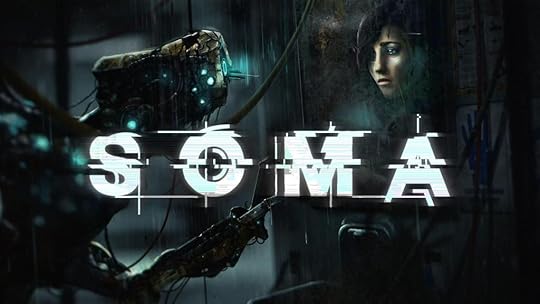Videogame: The Haunting Depths of Soma
In the shadowy depths of the ocean, where light is scarce and silence reigns, the Soma game invites players to confront the haunting mysteries of psychological horror. This unsettling adventure takes you beneath the waves into an environment that is as beautiful as it is terrifying, crafting an atmosphere that challenges your understanding of reality. As you navigate this underwater horror, you are forced to question the nature of consciousness and identity, probing existential themes that resonate deeply within the human psyche.
Through its intricate narrative exploration, Soma not only captivates but also provokes, leaving players to ponder what it truly means to be human. Prepare to be immersed in a chilling journey that blurs the lines between mind and machine, setting the stage for an unforgettable exploration of fear and philosophy.
 Immersive Underwater Horror
Immersive Underwater HorrorIn the Soma game, players are plunged into a world where isolation and darkness amplify fear. The game’s design leverages the vast, unknown expanse of the ocean to evoke a sense of claustrophobia and vulnerability. Players navigate through abandoned corridors and open waters, never knowing what lurks in the shadows.
The sound design plays a crucial role, with creaking metal and distant echoes enhancing the sense of dread. The absence of light further heightens the tension, making every shadow a potential threat. This sensory deprivation forces players to rely on their instincts, increasing the game’s suspense.
The underwater setting, with its unique challenges, compels players to confront their fears head-on. The experience is visceral, drawing players deeper into the narrative, where each creak and groan of the structure can signify impending danger.
Crafting the Haunting AtmosphereThe creators of Soma focused on crafting an atmosphere that is both beautiful and terrifying. Using environmental storytelling, the game conveys the history and fate of the underwater facility. Visual cues such as decaying structures and flickering lights suggest a world on the brink of collapse, offering clues to the narrative.
A careful balance is struck between realism and surrealism. The environment is meticulously detailed, with bioluminescent flora casting eerie glows, while the constant threat of being pursued keeps players alert.
The juxtaposition of serene beauty and lurking danger challenges the player’s perception of safety. The art direction contributes significantly, using color and light to evoke emotions ranging from wonder to terror. This careful crafting of atmosphere ensures players remain engaged and on edge throughout the experience.
 Exploring Existential Themes
Exploring Existential ThemesAt its core, Soma poses profound existential questions. The narrative forces players to confront the nature of their existence, exploring themes of consciousness and identity. Players are immersed in a world where human consciousness can be transferred to machines, blurring the lines between organic and artificial life.
The game prompts players to consider what it means to be human. Is consciousness tied to the physical body, or does it transcend it? These questions are woven into the gameplay, as players must make choices that challenge their moral and ethical beliefs.
Soma’s story is both engaging and unsettling, inviting players to ponder the implications of their actions. The existential dread it evokes is not only psychological but philosophical, leaving players with lingering thoughts long after the game ends.
Consciousness in GamesSoma’s exploration of consciousness in games sets it apart from traditional horror titles. The game’s narrative intricately examines the notion of self-awareness and the reliability of memory. Through its storytelling, players experience the fragility of identity and the impermanence of life.
The characters in Soma are not mere avatars; they are vessels through which players explore these philosophical questions. The game encourages players to question the nature of reality and their own perceptions, creating a deeply immersive experience.
As Game Developer notes, Soma’s approach to storytelling is both innovative and thought-provoking, making it a standout in the genre of psychological horror. This exploration of consciousness adds depth to the gameplay, engaging players on an intellectual level.
 Questions of Identity and Humanity
Questions of Identity and HumanitySoma delves into questions of identity, often blurring the lines between human and machine. Players confront scenarios where identity is not just a matter of physical form, but of consciousness and memory. The narrative forces players to grapple with the notion of self and what defines an individual.
Key plot points involve the transfer of consciousness, raising questions about continuity and identity. Is a person the sum of their memories, or does their existence rely on a physical form? These themes are explored through compelling character arcs and thought-provoking scenarios.
The game challenges players to consider their own beliefs about identity, prompting introspection and self-reflection. This exploration of identity is integral to Soma’s narrative, making it a profound psychological horror experience.
The Emotional Impact of StorytellingThe emotional impact of Soma’s storytelling is undeniable. Its narrative is deeply engaging, crafting an atmosphere that evokes a range of emotions from fear to empathy. Through its characters and plot development, the game builds an emotional connection with players.
Soma’s storytelling is praised for its ability to create tension and suspense. Players are drawn into the characters’ struggles, feeling their fears and hopes. This emotional engagement is amplified by the game’s immersive environment and sound design.
Soma’s narrative is both touching and chilling, as reviewed by Corrosion Hour. It leaves a lasting impression, as players reflect on the journey long after the game has ended. The emotional depth of the storytelling ensures that Soma remains a memorable experience, resonating with players and offering a rich exploration of fear and humanity.



